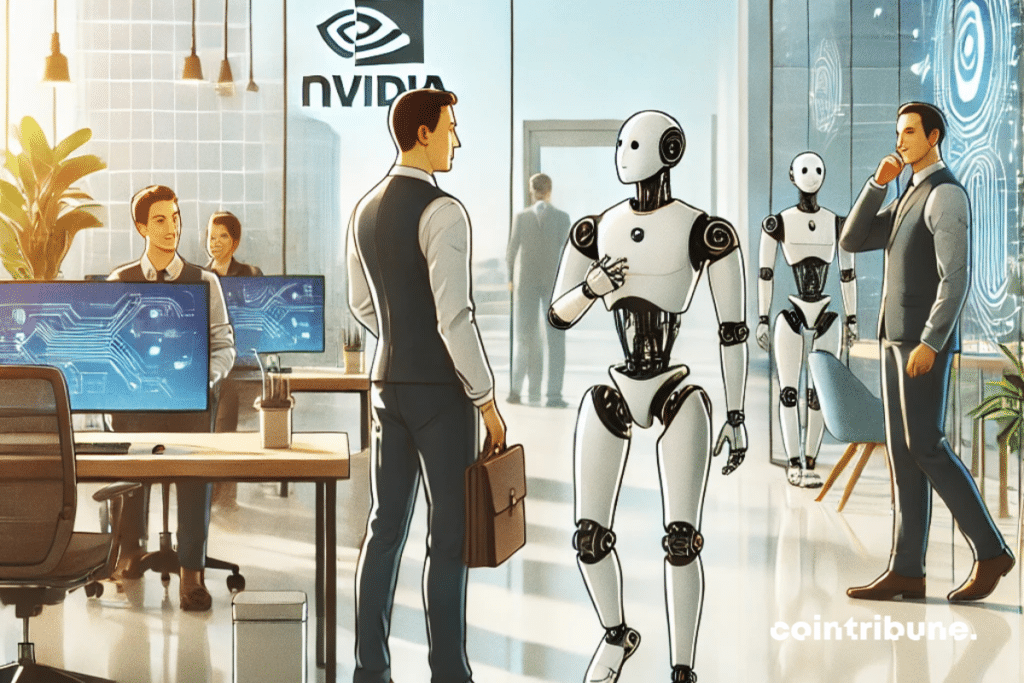Humanoid robots : Nvidia announces an imminent revolution
On the occasion of the World Congress on Innovation and Technology 2024, in Armenia from October 5 to 7, Nvidia unveiled ambitious plans to democratize humanoid robots that integrate advanced artificial intelligence. “Soon, these machines could live and work alongside us,” said Rev Lebaredian, vice president of Nvidia. An announcement that resonates with the rise of AI across all sectors of society. At the heart of this ambition, Nvidia envisions a revolution similar to that of smartphones, making all these robots accessible, which will mimic not only appearance but also human behavior.

Towards human-robot cohabitation in our living spaces
During his presentation, Rev Lebaredian shed further light on the necessity for these new robots to have a human appearance. He stated that “environments like factories, offices, or hospitals are designed for human beings. Rather than reshaping these spaces, it makes more sense to adapt the machines to the existing infrastructures.” This pragmatic vision reinforces the idea that humanoid robotics is not solely a matter of aesthetics but of functionality as well. By mimicking movements and human proportions, these robots will be able to perform various tasks in these spaces. Nvidia relies on its Omniverse platform to offer realistic simulations, which allows these robots to perfect their skills before being deployed in real-world situations.
For Nvidia, this approach allows for the design of robots with exceptional adaptation capabilities. Advances in AI facilitate the development of machines capable of walking, balancing their weight, and responding to the daily challenges of human tasks. Thus, these humanoid robots could transform the industrial landscape without requiring a redesign of infrastructures. By exploiting training models based on advanced simulations, Nvidia hopes to make the transition to a society assisted by humanoid robots as smooth as possible.
Accelerated adoption and profound social implications
Lebaredian also specified Nvidia’s ambitions to make these robots affordable and accessible to the greatest number. “Just as smartphones quickly became democratized, we believe these humanoid robots will also become widespread,” he explains. The company expects a drop in production costs and estimates that this innovation could be accessible both to businesses and individuals in the near future. This massive adoption would be a major step for several industries: humanoid robots could, for instance, assist medical teams during delicate interventions or help bridge the labor shortage in logistics, aiming to ensure increased productivity.
Nevertheless, the prospect of a wide integration of these humanoid robots also raises social and economic questions. While Nvidia envisions a rapid deployment, this technological revolution could transform the job market and introduce challenges related to employment and the necessary human skills in a world cohabiting with robots. Although Lebaredian expresses resolute optimism about the benefits of this innovation, the future remains uncertain, especially regarding societal repercussions and legislative adaptations that will be necessary to regulate this advancement. The coming years will therefore be decisive in determining whether this vision of humanized AI will genuinely contribute to simplifying our daily lives or introduce new, unprecedented problems.
Nvidia’s announcement opens a bright horizon for artificial intelligence and robotics, with the promise of unprecedented integration into our lives and workspaces. However, the democratization of humanoid robots raises critical questions about the balance between technological progress and social impact. While these machines can undeniably alleviate repetitive tasks and fill certain gaps, they also raise ethical and economic issues that cannot be ignored. Nvidia’s optimistic vision suggests a transitional period where human adaptation and regulation will be essential to prevent innovation from becoming a source of social fracture. Ultimately, this future cohabitation between humans and humanoid AIs will depend on our collective ability to harness it and anticipate its consequences.
Maximize your Cointribune experience with our "Read to Earn" program! For every article you read, earn points and access exclusive rewards. Sign up now and start earning benefits.
Diplômé de Sciences Po Toulouse et titulaire d'une certification consultant blockchain délivrée par Alyra, j'ai rejoint l'aventure Cointribune en 2019. Convaincu du potentiel de la blockchain pour transformer de nombreux secteurs de l'économie, j'ai pris l'engagement de sensibiliser et d'informer le grand public sur cet écosystème en constante évolution. Mon objectif est de permettre à chacun de mieux comprendre la blockchain et de saisir les opportunités qu'elle offre. Je m'efforce chaque jour de fournir une analyse objective de l'actualité, de décrypter les tendances du marché, de relayer les dernières innovations technologiques et de mettre en perspective les enjeux économiques et sociétaux de cette révolution en marche.
The views, thoughts, and opinions expressed in this article belong solely to the author, and should not be taken as investment advice. Do your own research before taking any investment decisions.